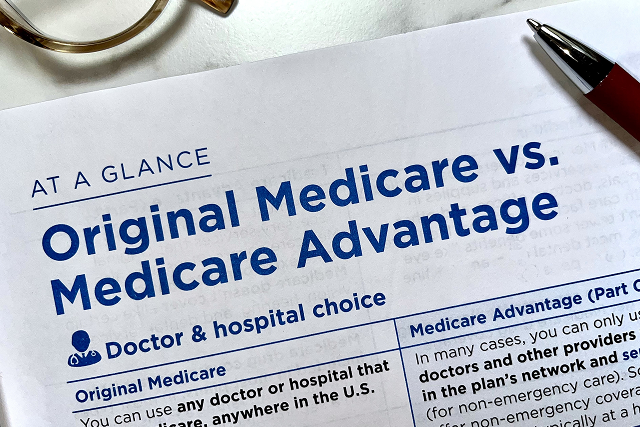Senior Insurance

Medicare Advantage vs. Original Medicare
Choosing the right Medicare plan is one of the most important decisions seniors can make regarding their health and finances. With so many options, understanding the differences, benefits, and potential drawbacks is essential.
This article explores the pros and cons of Original Medicare and Medicare Advantage, highlights what’s new in Medicare Advantage plans for 2025, and provides guidance on how to switch plans during open enrollment.
Understanding Medicare
Medicare is a federal health insurance program primarily for individuals aged 65 or older. Younger individuals with disabilities or certain medical conditions may also qualify. Medicare is crucial for millions of Americans, offering them access to health services and financial protection. However, not all Medicare plans are created equal, and selecting the right one can significantly impact your health coverage and out-of-pocket costs.
Two primary options exist for coverage:
- Original Medicare (Parts A and B).
- Medicare Advantage (Part C), which is offered by private insurance companies.
Understanding the differences between these plans is the first step in choosing what works best for you.
Original Medicare Overview
Original Medicare is the traditional government-run Medicare program that includes Part A (hospital insurance) and Part B (medical insurance).
What Does Original Medicare Cover?
- Part A (Hospital Insurance):
- Covers inpatient hospital stays, skilled nursing facility care, hospice care, and some home health services.
- Premiums for Part A are typically free if you or your spouse paid Medicare taxes for at least 10 years.
- Includes a deductible and coinsurance for services.
- Part B (Medical Insurance):
- Covers doctor visits, outpatient care, preventive services, and certain medical equipment.
- Requires a monthly premium, which can vary based on your income.
- Includes an annual deductible and coinsurance (you pay 20% of the costs for covered services after meeting the deductible).
Pros of Original Medicare
- Nationwide Coverage:
- No network restrictions, meaning you can see any doctor or specialist who accepts Medicare, anywhere in the U.S.
- Simplicity:
- Easy to understand, with predictable coverage across the country.
- Freedom of Choice:
- Referrals are not required to see specialists.
Cons of Original Medicare
- Gaps in Coverage:
- Original Medicare does not cover services like prescription drugs, dental, vision, hearing aids, or long-term care.
- High Out-of-Pocket Costs:
- There is no out-of-pocket maximum, which means catastrophic medical bills are possible without supplemental coverage (like Medigap).
- Limited Preventative Care Benefits:
- While preventative services are included, some routine services fall outside the plan’s scope.
Medicare Advantage Overview
Medicare Advantage, or Part C, is an all-in-one alternative to Original Medicare offered by private insurance companies. These plans include everything covered under Part A and Part B and typically include additional benefits like prescription drug coverage (Part D), dental, vision, and wellness programs.
How Medicare Advantage Differs from Original Medicare
- Medicare Advantage often works through managed care models like HMOs or PPOs, which may require you to use specific healthcare providers in their networks.
- Plans are private and vary significantly in cost, coverage, and out-of-pocket limits.
Pros of Medicare Advantage
- Extra Benefits:
- Includes coverage for dental, vision, hearing, fitness programs, and sometimes even transportation to medical appointments.
- Comprehensive Coverage:
- Often bundles Part A, Part B, and Part D (prescription drug) coverage into one convenient plan.
- Cost Predictability:
- Includes set annual out-of-pocket maximums, providing a financial safety net.
- Preventative Care:
- Many plans offer robust wellness programs and encourage preventative health measures.
Cons of Medicare Advantage
- Network Restrictions:
- Most plans limit you to a network of providers, which can restrict access to out-of-network care or specialists.
- Complexity:
- Plans vary greatly, and understanding the details of coverage, copays, and deductibles can be overwhelming.
- Service Area Limitations:
- Coverage may not extend outside of the plan's service area, making it less ideal for frequent travelers.
What’s New for Medicare Advantage Plans in 2025?
2025 is set to bring notable changes, particularly to Medicare Advantage plans. Here’s what’s on the horizon:
- Part B Premium and Deductible Adjustments:
- Expect an increase in Part B premiums and deductibles, particularly for higher-income beneficiaries.
- Expanded Telehealth Services:
- Medicare Advantage plans will expand coverage for telehealth visits, making healthcare more accessible, especially for rural enrollees.
- Part D Prescription Drug Updates:
- Enhanced cost-sharing measures will make prescription medication costs more predictable under Medicare Advantage plans.
- New Preventative Services:
- Several preventative services, including screenings and wellness programs, will be added to Medicare coverage.
- Changes in Medicare Savings Program Eligibility:
- Adjustments will make it easier for low-income beneficiaries to qualify for savings programs, reducing premiums and out-of-pocket costs.
- Plan Availability:
- More insurance companies are entering the Medicare Advantage market, offering greater variety and regional options for enrollees.
How to Switch Plans During Open Enrollment
If you’re considering switching to Medicare Advantage or modifying your current plan, open enrollment is your opportunity.
When Is Open Enrollment?
Open enrollment runs annually from October 15 to December 7. During this time, Medicare beneficiaries can:
- Switch from Original Medicare to a Medicare Advantage plan.
- Change from one Medicare Advantage plan to another.
- Add or drop Part D prescription drug coverage.
Step-by-Step Guide to Switching Plans
- Review Your Current Coverage:
- Analyze your current plan and identify gaps in coverage or rising costs.
- Research New Plans: - Use Medicare’s Plan Finder Tool or consult with an independent advisor to explore available options.
- Compare Costs and Benefits:
- Look at premiums, deductibles, provider networks, and additional benefits.
- Check Eligibility:
- Ensure you meet any eligibility criteria for the new plan.
- Enroll Through Medicare or Directly With Insurers:
- Make sure to complete the enrollment process before December 7 to ensure coverage starts on January 1.
Choosing the Right Plan for Your Needs
When deciding between Original Medicare and Medicare Advantage, the best option depends on your healthcare needs, budget, and lifestyle. Here’s what to keep in mind:
- Prefer flexibility and nationwide coverage? Original Medicare may be the right choice.
- Value extra benefits and lower out-of-pocket limits? Medicare Advantage offers a comprehensive solution.
To find a plan that fits your unique needs and get personalized advice, reach out to a Medicare specialist or visit a trusted resource like Medicare.gov.




